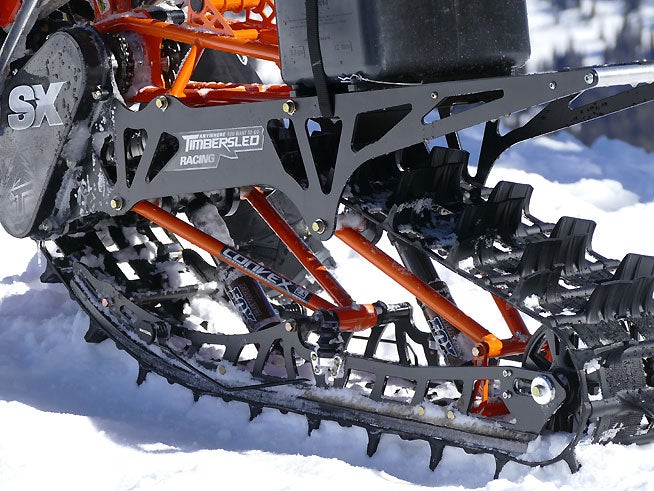
The Technical Stuff
Timbersled now markets three different conversion kits with tracks of varying lengths. Choosing the right one depends upon the displacement of the motorcycle, rider skill and the snow conditions that the rider will encounter. Timbersled is happy to help customers make the right choice for their needs.
-Timbersled Short Track [ST] Conversion Kit, $5300
The ST is Timbersled’s most versatile kit. It works with 250cc four-strokes, and 250cc or 300cc two-strokes as well as four-stroke models, and it is even claimed to be able to withstand power from anything up to and including high-horsepower turbocharged engine. The ST is also claimed to be capable in deep powder as well as hard-packed snow.
-Timbersled Long Track [LT] Conversion Kit, $6000
The LT’s forte is deep, powdery snow, such as is found in Western mountains. The LT is also recommended for riders weighing over 220 lbs. because its longer track offers delivers better floatation than the ST.
Caption: Timbersled-Exclusive-6
The front of a snowbike is held up by a single ski that attaches to the fork. The beauty of a snowbike is that it can be converted back to a dirtbike in just a few hours.
-Timbersled Snow Cross SX120 $(5800) and SX137 ($6500) Conversion Kits
Originally developed for purpose-built race machines, the SX kits are designed to be more responsive than the LT or ST, and they also offer the most suspension travel. The SX’s 2-inch narrower (10.5-inch) track, chassis and suspension geometries deliver more maneuverability for snowcross tracks. As its model designations imply, the kit is available in either a 120-inch or 137-inch track length.
The Timbersled Mountain Horse kit can be installed on most popular dirtbike models, including but not limited to Yamaha, Kawasaki, Suzuki, Honda, KTM, Husqvarna and Beta, and it’s actually surprising just how well-suited the typical 450cc four-stroke dirt burner is when it comes to making the conversion from dirtbike to snowbike. The rev-happy, electronically fuel-injected (EFI) Singles have more ample torque and horsepower to sling the Mountain Horse track with ease, even at high altitudes. Two-stroke dirtbikes such as the KTM and Husqvarna 300s can also muster the power to work with the Mountain Horse kit, but, as the old saying goes, there’s no replacement for displacement. It should also be noted that electric-start models are also preferred due to the fact that solid footing isn’t always available if you should go down in deep snow and need to restart your stalled snowbike.
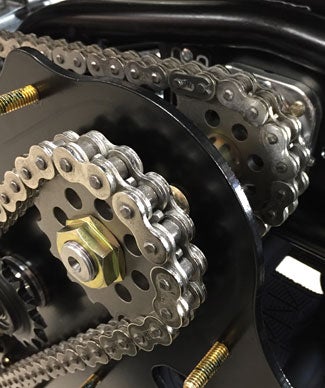
Installing the kit is neither difficult nor permanent—it’s a true bolt-on operation. The rear suspension replaces the swingarm, and a “tunnel extension with snowflap” replaces the rear fender. A wide, Simmons ski, designed exclusively for the Mountain Horse kit, replaces the front tire. The track, designed by Timbersled and built by Camoplast is specific to the Mountain Horse in terms of lug pattern, pitch and lug duometer (a ratio of lug stiffness at base and flexibility at tip) is unique to the snowbike. The lugs are 2.5 inches long.
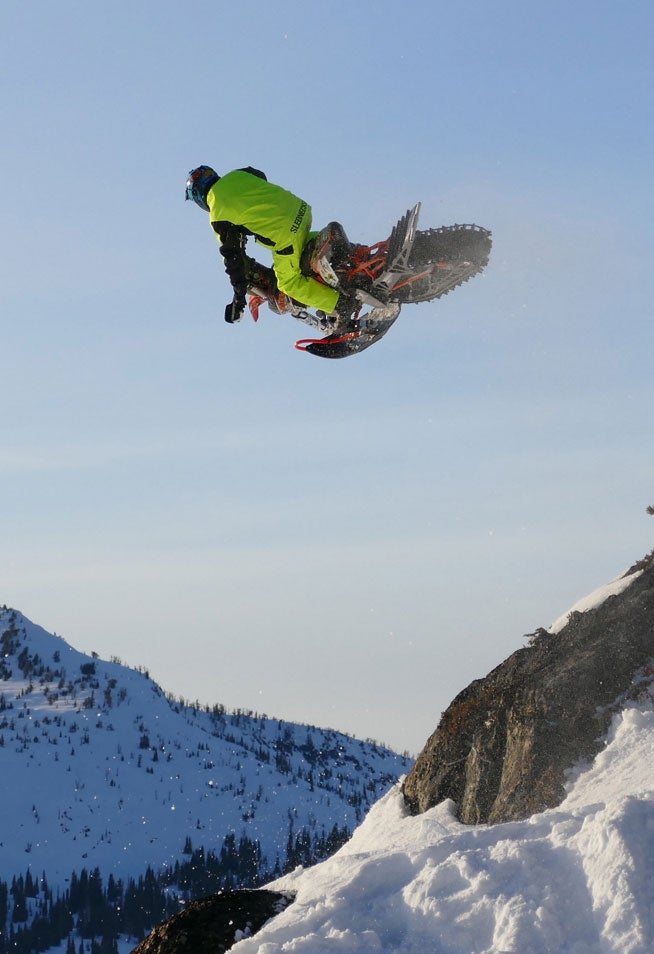
The Ride
When I first rode a Timbersled Mountain Horse, I found that learning to master the longer motorcycle with a track and ski, only took about an hour. My tutor was Mangum himself, and we swapped back and forth between a Honda CRF450R and Yamaha YZ450F. This past winter, I spent a day on two Yamaha WR450Fs at the exact location where Mangum introduced me to the sport three years ago. Riding a 450cc dirtbike in the backcountry is something that will be familiar to most of our readers, but replace the rear wheel with a 120- or 137-inch long, 12.50 -inch wide track that places 1500 or 1712.50 square-inches of tread on the ground, and replace the front wheel with a ski that is almost as wide as a snowboard. It’s an amazingly different and very cool experience.
However, riding a snowbike on a hardpacked trail is not fun at all because a snowbike is not nearly as responsive to standard motorcycle steering inputs when the snow is firm. With its long track and ski, the bike’s steering geometry is significantly altered. The track’s width resists the usual tendency for the bike to lean into corners, and its length causes the bike to understeer in concrete-like snow. Thus, the closer the backcountry is to the trailhead, the better. The ST kit works best with snow depths of 1 or 2 feet, but the LT kit can easily handle 3 feet of powder, especially if equipped with the optional TSS kit.
Once off the trail or out of the parking lot, the Timbersled Mountain Horse becomes what it is, a light and slim “snowmobile” with a single ski and narrow track. So, what’s it like? Twist the throttle, bang into first, then second and third and let it float. Don’t expect explosive four-stroke or two-stroke power like a dirt bike. Instead, you’ll feel gentle even acceleration that feels more like it comes from an electric motor than an internal combustion engine. You also won’t need to row the gearbox. Most people ride their snowbikes using just second and third gear.
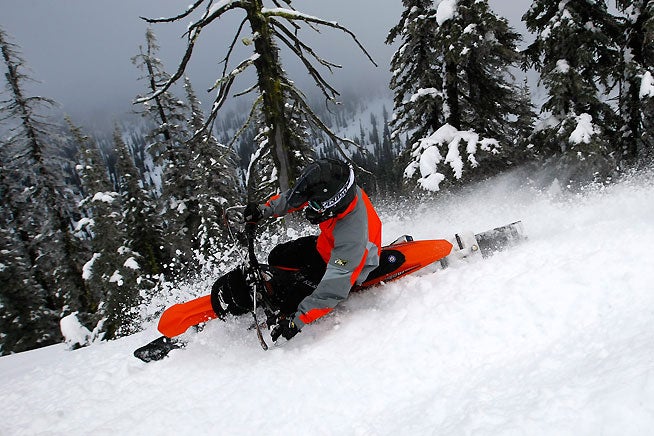
Handling is also different. In powder, a snowbike is a very fun and forgiving ride once a rider adapts to its balance and steering characteristics. For starters, he or she quickly learns to resist standing on the foot pegs most of the time. There are times to stand, but it is easiest to learn to lean and jockey the snowbike when seated. You simply sit, relax, and give the bars gentle inputs to initiate a turn, with a dropped inside shoulder helping to point you where you want to go as you sight you pick your cornering line. Do that, and the snowbike will obediently turn right or left, but you must remember not to turn too sharply or chop the throttle, or down you’ll go. There really is no such thing as freewheeling with a track. Remember that the throttle is your friend as a snowbike will stick to powder-laden mountain terrain like a magnet on steel.
The long-travel front fork and long travel rear skidframe prevents the bike from porpoising, and does such a good job of taming what few bumps you’re likely to encounter that arm pump is virtually non-existent. Still, a snowbike handles whoops rather well. Instinctively, you’ll want to stand, but stay seated and let the two suspension systems manage the impact energy. There’s no teeth-rattling feeback through the bars or seat, but rather just a gentle rolling feel as the front and rear suspension do their job.
And sidehilling a snowbike is all but guaranteed to twist the senses. Have a 30-degree or greater slope in your way? No problem. First, scope out your line, and lean the bike into the hill as you hit the gears. With momentum to keep the snowbike upright, the ski and track quickly builds a shelf. Snowbikes don’t wash out the front or rear end.
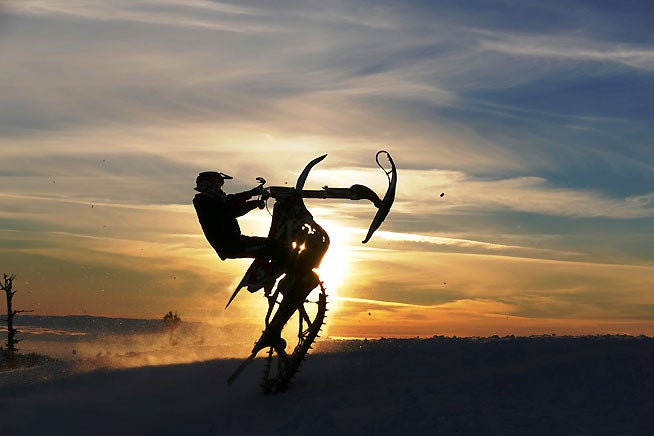
One other thing—and this is critically important: If you are planning to ride a snowbike, become avalanche smart and make sure to carry the proper equipment to protect yourself, including a beacon, a probe, a small shovel and an avalanche air bag (aka, an avy bag). Look to Klim (www.klim.com) and MotorFist (www.motorfist.com) to outfit your body.
Most people can expect to spend a couple hours learning the different riding style that the snowbike requires. Allow it to teach you, and you should be able to master it. Snowbikes want—no, beg—to be ridden.
 Your Privacy Choices
Your Privacy Choices